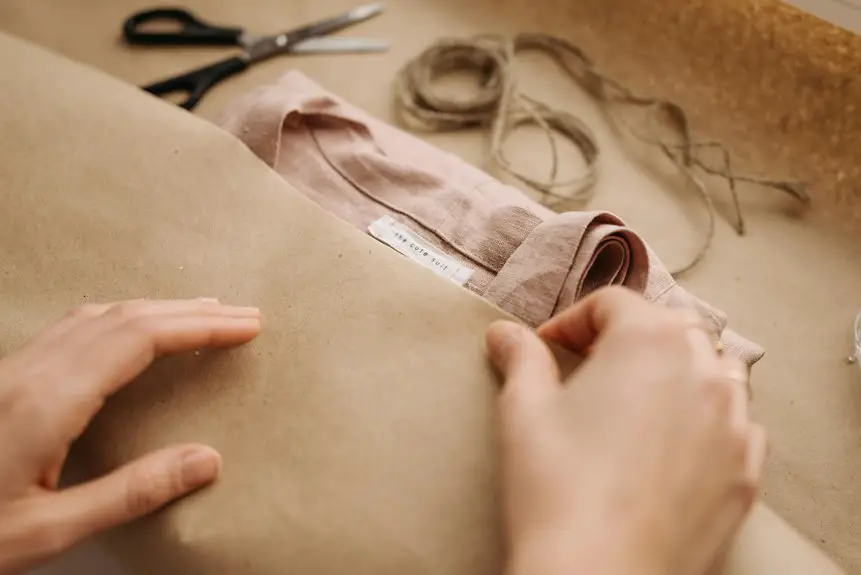Ramie fabric is a strong, natural fiber from the nettle family that offers durability, moisture absorption, and a lovely silky sheen. You’ll find it perfect for lightweight clothing, home décor, and even industrial uses due to its resistance to wear, mildew, and insects. Caring for ramie means gentle washing, avoiding bleach, and air drying to keep it looking great. If you want to explore ramie’s benefits, comparisons, and stylish applications, there’s plenty to discover next.
Table of Contents
Key Takeaways
- Ramie fabric is a strong, durable, and naturally lustrous fiber derived from the stalks of the ramie plant.
- It resists mildew, insect damage, stretching, and withstands frequent washing without losing integrity.
- Common uses include summer clothing, home furnishings like curtains and upholstery, and industrial textiles.
- Care involves gentle hand washing with mild detergent, avoiding bleach, air drying in shade, and low-heat ironing.
- Ramie is eco-friendly, requiring less water and pesticides than cotton, and is biodegradable and sustainable.
What Is Ramie Fabric and How Is It Made?
Ramie fabric is a natural fiber derived from the stalks of the ramie plant, a member of the nettle family. When you handle ramie, you’re working with one of the oldest known fibers, valued for its strength and luster.
To make ramie fabric, the stalks are first harvested and then crushed to separate the outer bark from the inner fibers. You’ll find that these fibers undergo a process called degumming, which removes gummy substances to soften them.
Afterward, the fibers are spun into yarn, either alone or blended with other fibers like cotton or wool. This yarn is then woven or knitted into fabric.
When you explore ramie fabric, you’re appreciating a textile created through a meticulous, natural process that’s been refined over centuries.
Key Properties and Benefits of Ramie Fabric
You’ll appreciate ramie fabric’s incredible durability and strength, making it a reliable choice for long-lasting garments.
It also excels at absorbing moisture and staying breathable, keeping you comfortable in warm weather.
Let’s explore how these properties benefit you in everyday use.
Durability and Strength
Although natural fibers can vary widely in strength, this one stands out for its exceptional durability. When you choose ramie fabric, you’re getting a material that resists wear and tear better than many other natural fibers.
You’ll appreciate how well it holds up over time, maintaining its structure and appearance even with frequent use.
Here’s why ramie fabric’s durability benefits you:
- High tensile strength makes it resistant to stretching and breaking.
- It withstands frequent washing without losing integrity.
- The fiber resists mildew and insect damage, extending fabric life.
- Ramie maintains shape and resists wrinkling, keeping your items looking fresh.
This toughness makes ramie an excellent choice for both fashion and home textiles.
Moisture Absorption and Breathability
Beyond its toughness, this fabric also excels at keeping you comfortable by managing moisture effectively.
Ramie fibers absorb water quickly, pulling sweat away from your skin and allowing it to evaporate faster. This natural moisture-wicking ability helps you stay dry, especially in hot or humid conditions.
Plus, ramie’s breathability lets air circulate freely through the fabric, preventing heat buildup and reducing discomfort.
When you wear ramie clothing, you’ll notice it feels cool and fresh, even during intense activity or warm weather.
Its moisture absorption and breathability make ramie an excellent choice for summer wear or active lifestyles.
You’ll appreciate how it balances durability with comfort, keeping you cool and dry all day long.
Common Applications and Uses of Ramie
You’ll find ramie fabric used in a variety of ways, from apparel and textiles to home furnishings.
Its strength and durability make it ideal for items like curtains, upholstery, and even industrial products.
Let’s explore how ramie fits into these different applications.
Apparel and Textiles
Many designers and manufacturers choose ramie for its strength and natural luster, making it a popular fabric in apparel and textiles.
You’ll find ramie used in various clothing items and textile products because it’s breathable, durable, and holds dye well. When you pick ramie, you’re opting for comfort and style with an eco-friendly edge.
Here are common applications of ramie in apparel and textiles:
- Summer clothing like dresses and shirts, thanks to its breathability.
- Blended fabrics with cotton or wool for enhanced texture and durability.
- Lightweight scarves and shawls that feel soft against your skin.
- Industrial textiles such as sewing threads and canvas due to its strength.
Ramie adds versatility and resilience to your wardrobe choices.
Home Furnishings
Although ramie is well-known for apparel, it also excels in home furnishings due to its durability and natural sheen. You’ll find ramie used in curtains, upholstery, and table linens, where its strength helps resist wear and tear.
Its natural luster adds a subtle elegance to your living spaces without the need for synthetic fibers. Because ramie breathes well and dries quickly, it’s perfect for cushions and slipcovers in rooms that get a lot of sunlight or humidity.
Plus, its resistance to mildew means your home textiles stay fresher longer. When you choose ramie for your home, you’re opting for a fabric that combines beauty with practicality, making your décor both stylish and long-lasting.
Industrial Uses
Ramie serves a variety of industrial purposes thanks to its strength and resistance to moisture. When you choose ramie for industrial use, you benefit from its durability and natural luster.
It’s often combined with other fibers to enhance performance in demanding environments. Here are some common applications where ramie excels:
- Automotive textiles – for seat covers and interior linings due to its toughness.
- Geotextiles – used in erosion control and soil stabilization because it resists moisture well.
- Industrial sewing threads – valued for strength and resistance to mildew.
- Composite materials – as reinforcement in plastics and building materials for added durability.
Comparing Ramie to Other Natural Fibers
When you compare ramie to other natural fibers like cotton, linen, and hemp, you’ll notice it offers a unique blend of strength and luster.
Ramie is stronger than cotton and even linen, making it highly durable for various uses. Unlike cotton’s softness, ramie has a silky sheen that adds a subtle shine to fabrics.
Compared to hemp, ramie feels smoother and less coarse, which can be more comfortable in clothing. It also resists wrinkles better than linen, though it doesn’t stretch as much as cotton.
While ramie absorbs moisture well, it dries faster than cotton but slower than linen.
Understanding these differences helps you choose ramie when you want a fabric that’s strong, shiny, and breathable, standing out among other natural fibers.
Tips for Cleaning and Maintaining Ramie Fabric
Since ramie fabric combines strength with a delicate sheen, you should treat it with care during cleaning to maintain its appearance and durability.
To keep your ramie items looking their best, follow these essential tips:
- Wash ramie in cold or lukewarm water using a gentle cycle or hand wash to prevent damage.
- Use mild detergent to avoid harsh chemicals that can weaken fibers or dull the fabric’s luster.
- Avoid wringing or twisting ramie; instead, gently squeeze out excess water to preserve its shape.
- Air dry your ramie fabric flat or hang it in the shade to prevent shrinkage and color fading.
Styling Ideas and Trends With Ramie Textiles
Although natural fibers are trending, you’ll find ramie textiles offer a unique blend of durability and elegance that fits perfectly with modern styles.
Ramie textiles combine durability and elegance, making them ideal for chic, modern wardrobes.
You can incorporate ramie into your wardrobe with lightweight shirts, tailored pants, or flowy summer dresses that breathe well and look polished.
For home decor, try ramie cushion covers or curtains to add texture without sacrificing durability.
Pair ramie pieces with natural tones or vibrant colors to highlight its subtle sheen.
Right now, oversized ramie blazers and wide-leg trousers are in vogue, giving you a chic yet comfortable look.
Don’t hesitate to mix ramie with cotton or linen for layered, breathable outfits.
With its versatility, ramie lets you stay stylish and eco-conscious effortlessly.
Frequently Asked Questions
Is Ramie Fabric Environmentally Sustainable?
You’ll find ramie fabric is environmentally sustainable because it’s a natural fiber that requires less water and pesticides than cotton. Plus, it’s biodegradable, so you’re making an eco-friendly choice when you use it.
Can Ramie Cause Allergies or Skin Irritation?
About 5% of people experience skin irritation from plant fibers like ramie. You might find it causes mild allergies or itchiness, especially if your skin’s sensitive, so it’s wise to test a small patch first.
What Is the History of Ramie Use in Textiles?
You’ll find ramie’s history dates back thousands of years in Asia, especially China. People have used it for textiles because of its strength and luster, weaving it into fabrics before cotton became widespread.
How Does Ramie Fabric React to Dyeing Processes?
You might wonder if ramie fabric takes dye well—it does, but it’s tricky. Its natural stiffness resists color absorption, so you’ll need mordants or heat treatments to get vibrant, lasting hues that won’t easily fade.
Are There Any Cultural Significances Associated With Ramie?
You’ll find ramie holds cultural significance in East Asia, especially China, where it’s linked to traditional clothing and rituals. People appreciate its natural sheen and durability, symbolizing purity and longevity in various ceremonies.
- The Use of Nonwovens in Construction and Civil Engineering - July 11, 2025
- The Use of Nonwovens in Construction and Civil Engineering - July 11, 2025
- The Use of Nonwovens in Construction and Civil Engineering - July 11, 2025







